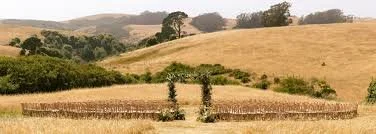The three weeks of mourning. 17th of Tammuz to 9nth of Av.
“Next He [this refers to the Presence of God who is guiding him during a vision that starts chapter 8] brought me to the entrance of the North Gate of the House of the Lord, between the portico and the altar and there sat the women bewailing Tammuz.” (Ezekiel 8:14).
Why did the people mourn? What did they hope to accomplish? To understand this we have to understand the Israelite ecosystem. Israel, like California, but unlike the east coast where I live, is a two season climate—hopefully wet in winter and dry in summer. The winter rains bring an explosion of green in spring that is almost all gone by the time of high summer. Brown and burnt yellow are the colors of the summer under a hot, cloudless sky. Just as our ancestors prayed for it to stop raining at Pesach so they could have a successful grain harvest, so they wept and wailed for the death of Tammuz so that he would be reborn with the Fall rains.
How do I know that is what they felt? Here’s what they said, according to Jeremiah another prophet of YHVH who bitterly opposed the practice of wailing for Tammuz. “Thereupon they answered Jeremiah, all the men who knew that their wives made offerings to other Gods; all the women present, a large gathering, and all the people who lives in Pathos in the land of Egypt. “We will not listen to you in the matter about which you spoke to us in the name of YHVH. On the contrary, we will do everything that we have vowed to make offerings to the Queen of heaven and to pour libations to her as we used to do, we and our fathers, our kings and our officials, in the towns of Judah and the streets of Jerusalem. For then we had plenty to eat, we were well off and suffered no misfortune.” (Jeremiah 44:15-17).
Tammuz is both a month and a Sumerian God. In the Babylonian myth which was celebrated by our ancestors, Tammuz is a shepherd God who dies with the summer and goes to the underworld. He is rescued by the Goddess Inanna/Ishtar and is reborn in the fall when the rains start again, after Sukkot.
He is reborn, our ancestors believed, because the women participated in mourning his death. This participation in healing and maintaining the cosmic order of rain in season is exactly the same kind of project as Jews influenced by Lurianic Kabbalah undertake when they work to repair the world, what we call Tikkun Olam.
You might know this three week period or the holiday of Tisha B’av at the end of the three weeks better for our mourning of a series of historical disasters culminating in the destruction of both the first and second temple. The typical approach of our Yahwist ancestors, the prophets, priests, scribes and Rabbis who wrote and edited our sacred texts is to overlay an historical theological meaning onto the more ancient spirituality rooted in our agricultural cycles. Yet the original agricultural/spiritual meaning is still there, ready for us to reclaim.
We all have much to grieve. I am following Francis Weller’s five gates of grief here. There’s grief for our personal losses. There’s grief for the parts of ourselves that we rejected because they weren’t acceptable to our families or to society. There’s grief for the pain of the natural world as all beings suffer from human created climate change. There’s grief for our lack of belonging to both human community and to a place. There’s ancestral grief, pain that we carry from the pain of our ancestors. This is particularly appropriate for us as Jews in this time period.
Grief, Weller argues and I completely agree, is absolutely essential for spiritual maturity. So take this opportunity to do some grief work. Feel into any of the sources of grief and let yourself feel your grief and cry or scream or sob. Watch a tearjerker movie or read a sappy book and let yourself cry at the end. We all have much to grieve.
